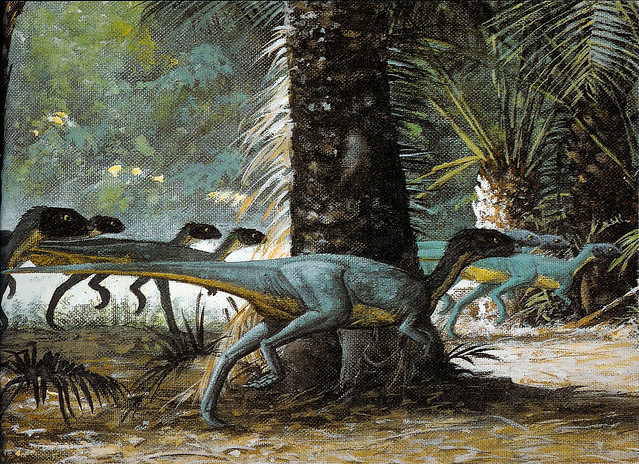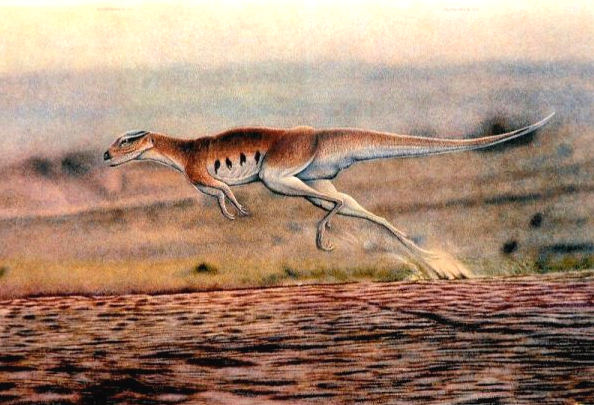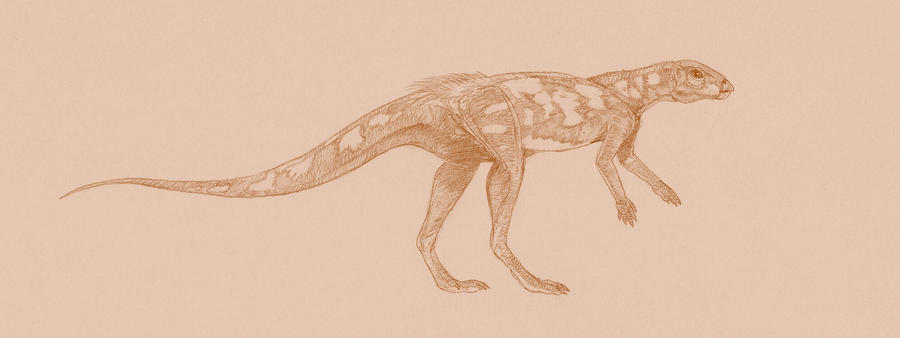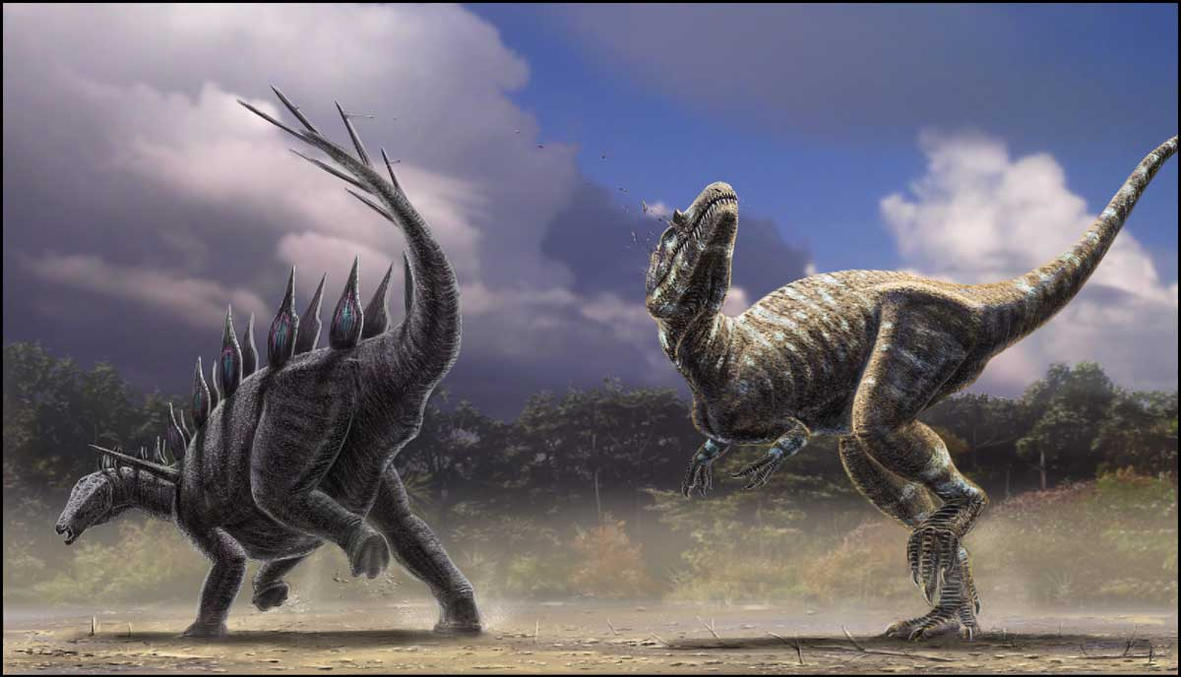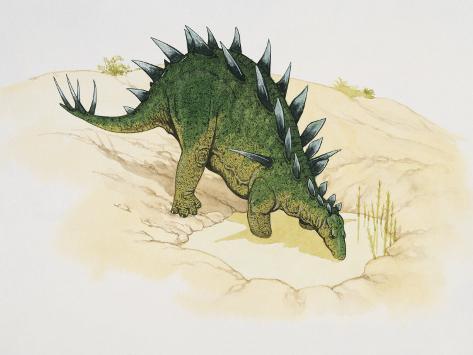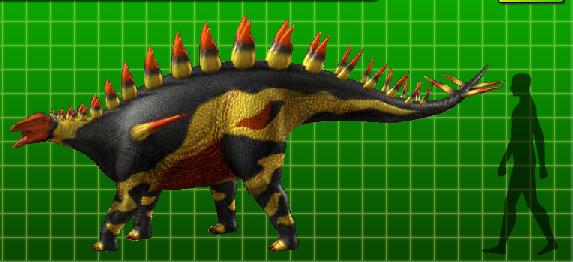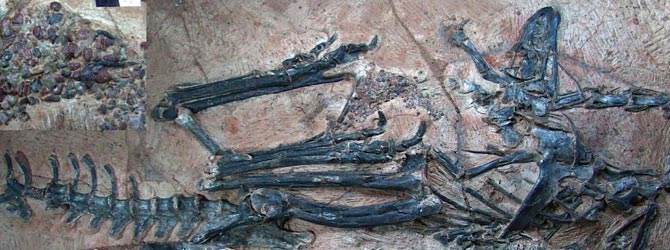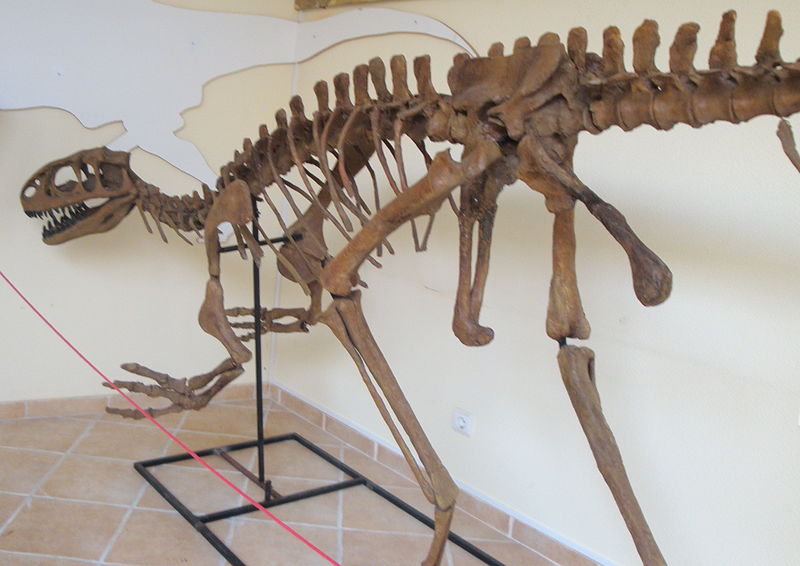[Recent Entries][Archive][Friends][User Info]
November 1st, 2012
| November 1st, 2012 | |
|---|---|
| 06:26 pm [industrialterro] [Link] |
Lesothosaurus Лесотозавр (Lesothosaurus diagnosticus, «ящер из Лесото») — примитивный птицетазовый динозавр из нижней юры (верхнего триаса?) Лесото. Этот род пока плохо изучен, но уже ясны некоторые подробности его анатомии, что даёт представление о других фаброзавридах. Длина животного не превышала 1 м. Передвигался лесотозавр на двух лапах. Передние лапы были укорочены и приспособлены для обхватывания. У лесотозавра были пятипалые передние конечности и относительно крупная голова, что показывало что лесотозавр — примитивный птицетазовый динозавр. Lesothosaurus is an herbivorous ornithischian dinosaur. It was named by paleontologist Peter Galton in 1978, the name meaning "lizard from Lesotho". The genus is monotypic, having only one valid species, Lesothosaurus diagnosticus, within the genus. Lesothosaurus was originally considered an ornithopod. However, more recent work by Paul Sereno has suggested that it may actually represent one of the most primitive of all known ornithischian dinosaurs. The taxonomic history of Lesothosaurus is complex and it has long been confused with Fabrosaurus, another small ornithischian from the same locality. In 2005, Richard J. Butler published a new phylogenetic study of ornithischians, in which he proposed that Lesothosaurus was a basal member of the clade Neornithischia, which includes pachycephalosaurs, ceratopsians and ornithopods. Alternatively, this dinosaur may be a very early thyreophoran, a member of the group including the armored stegosaurians and ankylosaurians. Stormbergia may represent the adult form of Lesothosaurus. Lesothosaurus was a 1 metre (3.3 ft) long, bipedal plant-eater. Its long legs, small arms, and slender tail all suggest that it was a fast runner; it would have resembled a large lizard walking bipedally. The small skull of Lesothosaurus was short and flat, with large eye sockets. It had large cavities for the eye and jaw muscles. It had a short, pointed snout, and the lower jaw may have ended in a beak. Its teeth were pointed with grooved edges, and would have been ideal for chewing tough plant matter. The skull was mounted on a short but flexible neck. The hind limbs of Lesothosaurus were much longer than the forelimbs, which were quite short with small 'hands'. The hand had four well-developed fingers and a smaller fifth finger. The length of the rear legs indicates Lesothosaurus was a fast, agile runner. The distinctive femur has a unique femoral head not seen in other dinosaurs. Lesothosaurus lived in the hot, arid conditions of Lesotho and South Africa, during the Early Jurassic. Remains of Lesothosaurus have been collected from the Upper Elliot Formation, dating it to the Hettangian to Sinemurian portions of the Early Jurassic. ( Read More )
Размеры тела в сравнении с человеком и курицей:
Tags: Вымершие рептилии, Юра, авеметатарзалии, архозавроморфы, архозавры, диапсиды, динозавроморфы, динозавры, птицетазовые |
| Time | Event |
| 07:27 pm [industrialterro] [Link] |
Lexovisaurus Lexovisaurus was one of the first dinosaurs from mid-to-Late Jurassic Europe, 164.7 mya to be discovered. It was a stegosaur. Its fossils (pieces of armor and limb bones) have been found in France and northern England. The French specimens show that Lexovisaurus was probably rather like Stegosaurus. Traditionally, this dinosaur was depicted as having either large spines over the hips or shoulders, with a selection of flat plates and round pointed spines that ran along the back and tail. Lexovisaurus was probably about 5 m (16.5 ft) long. The type specimen, Lexovisaurus durobrivensis, was formalized by Hoffstetter in 1957. The specimen was originally placed in Omosaurus (now Dacentrurus) 70 years earlier. Recent work by Susannah Maidment and colleagues indicates that Lexovisaurus is based on undiagnostic remains, so these workers coined Loricatosaurus to hold other remains that had been assigned to Lexovisaurus.
Размеры тела в сравнении с человеком:
Tags: Вымершие рептилии, Юра, авеметатарзалии, архозавроморфы, архозавры, диапсиды, динозавроморфы, динозавры, птицетазовые, стегозавры, тиреофоры |
| Time | Event |
| 07:45 pm [industrialterro] [Link] |
Limusaurus Limusaurus inextricabilis Xu et al., 2009 — юрский динозавр, который найден в Китае и может являться переходной формой между динозаврами и птицами. Останки в виде трёх хорошо сохранившихся скелетов обнаружены в Джунгарском котловане в Китае и описаны коллективом из 15 ученых из Китая, Мексики и США. Возраст находки от 156 миллионов до 161 миллиона лет. Это — первый цератозавр из восточной Азии и один из самых древних. Возраст самих динозавров определен как весьма молодой (6 лет для одного из экземпляров). Limusaurus inextricabilis обладал короткими передними и длинными задними конечностями и длинной шеей с общей длиной тела около 1,7 метров. Новый ящер был предположительно травоядным, на это указывает клювовидное (без зубов) строение передней части его морды (приспособление для разгрызания семян и орехов) и обнаружение в останках желудка мышечных волокон особой структуры и камней (гастролитов). Первый палец передних конечностей сильно редуцирован, что заставило исследователей провести перенумерацию всех пальцев. Тероподы обладают трехпалыми конечностями. Изучение передних конечностей показало, что пальцы теропод, которые до сих пор считались первым, вторым и третьим (I-II-III), в действительности являются вторым, третьим и четвертым (II-III-IV). То есть, именно так, как эмбриология предполагает гомологию пальцев у современных птиц. The type, and to date the only species, L. inextricabilis, was described in a 2009 paper coauthored by X. Xu, J. M. Clark, J. Mo, J. Choiniere, C. A. Forster, G. M. Erickson, D. W. E. Hone, C. Sullivan, D. A. Eberth, S. Nesbitt, Q. Zhao, R. Hernandez, C.-K Jia, F.-L. Han, and Y. Guo in the journal Nature. It is known from two subadult specimens found in close connection; the holotype, (IVPP) V 15923, is an almost complete articulated skeleton, and the other, IVPP V 15924, is a nearly completely articulated specimen, only missing the skull. The second specimen is 15% larger than the holotype. A third referred specimen is IVPP V16134. All specimens were young adults when they died, as can be concluded from the extent of bone fusion; from growth lines it was inferred that IVPP V 15924 was in its sixth year when it died. Limusaurus had a small slender body measuring about 1.7 m in length. It is the first definite ceratosaur from eastern Asia to be discovered and one of the earliest. Its discovery shows that the Asian dinosaurian fauna was less endemic during the Middle/Late Jurassic period than previously thought and suggests a possible land connection between Asia and other continents during that period. Limusaurus is a basal ceratosaur that shares many characteristics with coelophysoids and tetanurans. The features present in Limusaurus led to the conclusion that there is a close relationship between the clades Ceratosauria and Tetanurae. Limusaurus shares several cranial features with other ceratosaurs and coelophysids but displays some unique characteristics for the group, such as absence of teeth and the presence of a fully developed beak (rhamphotheca), which have been previously reported in non-avian theropods only among the Cretaceous coelurosaurs. Limusaurus has a long neck, short forelimbs and elongated hindlimbs indicating strong cursorial (running) capabilities. The presence of gastroliths in the stomach of both specimens and the toothless beak indicate a herbivorous diet, making it the earliest and most basal theropod to become adapted to eating plants. The overall aspect of the animal is very similar to that of the Cretaceous ornithomimid theropods, as well as the Triassic non-dinosaurian archosaur Effigia, representing a remarkable case of convergent evolution among these three distinct groups of archosaurs. Limusaurus was a very basal ceratosaur characterized by hands retaining four digits (I–IV), digit I being strongly reduced. It was traditionally thought that the hands of dinosaurs evolved into the wings of birds by the disappearance of the two outward digits (IV and V), in contradiction to embryological studies on birds that showed that the retained digits are the three middle ones (II–III–IV). The hand structure of Limusaurus with its reduced digit I adds more weight to the digit II–III–IV identities for Tetanurae, among which are birds. Previous to the discovery of Limusaurus, theropods were assumed to have progressively evolved reduced digits on the ulnar side of the manus. This concept, known as Lateral Digit Reduction (LDR) is in contrast to Bilateral Digit Reduction (BDR), the reduction on digits on both sides of the hand commonly seen in all other tetrapod groups excluding dinosaurs. However, in Limusaurus, the first digit (Digit I) is strongly reduced, along with other ceratosaurs, suggesting that BDR occurred in their sister group the Tetanurae as well. Previously, it was thought that digits I–III were retained in tetanurans as a homology with basal theropods, giving credence to the LDR hypothesis. However, the evidence of BDR in Limusaurus suggests that other non-avian theropods may also have exhibited BDR and the apparent digits I–III in tetanurans may actually be digits II–IV, a previous idea considered by Thulborn and Hamley, but largely ignored in the paleontological community. Despite the interesting possibilities brought up by Limusaurus, paleontologists are unlikely to stop calling tetanuran digits I, II, and III and switch to calling them II, III, IV. This is because most of their morphological traits resemble those of digits I, II and III of other theropods. It remains possible that bilateral digit reduction occurred in Ceratosauria but not in Tetanurae. The embryology of the bird wing could be explained by a homeotic frameshift of digital identity, as suggested by recent gene expression and experimental data.
Размеры тела в сравнении с человеком:
Ископаемые останки (1, 2, 3, 4, 5):
Tags: Вымершие рептилии, Юра, авеметатарзалии, архозавроморфы, архозавры, диапсиды, динозавроморфы, динозавры, тероподы, цератозавры, ящеротазовые |
| Time | Event |
| 08:21 pm [industrialterro] [Link] |
Lourinhanosaurus Lourinhanosaurus (meaning "Lourinhã [Formation] lizard") was a carnivorous theropod dinosaur genus that lived during the Late Jurassic Period (Kimmeridgian/Tithonian). Its first remains were found at Peralta, near Lourinhã, Portugal in 1982, but were not described until 1998, by Portuguese paleontologist Octávio Mateus. Its type (and to date only) species is L. antunesi, in honour of Portuguese paleontologist Miguel Telles Antunes. To date, the most complete specimen of L. antunesi found is a partial skeleton. The holotype, ML 370, consists of the remains of six cervical vertebrae with six ribs, five sacral vertebrae with ribs, 14 caudal vertebrae, eight chevrons, both femora, right tibia and fibula, one metatarsus, two ilia and both pubes and ischia, as well as an associated 32 gastroliths. A femur (ML 555) found at Porto das Barcas (Lourinhã Formation; Late Jurassic) has also been referred to L. antunesi. Besides these specimens, around 100 eggs (specimen number ML 565), some of them containing embryonic bones, have been found in 1993 at the nearby beach of Paimogo. These were soon assigned to L. antunesi. Both the skeleton and the eggs are on display at Museu da Lourinhã. Relationships of Lourinhanosaurus have been uncertain, and no firm consensus has been reached as to its relationships. Initially regarded as a primitive member of Allosauroidea, it was later discussed as being closely related to Sinraptoridae, a more inclusive clade within Allosauroidea. Recently, some researchers have been favourable to the idea that L. antunesi is not even an allosauroid, but in fact a member of Megalosauroidea, a more primitive group of tetanuran theropods. Benson et al. (2010) found it and Poekilopleuron to belong to Sinraptoridae. Carrano et al. (2012) found it to be a coelurosaur. L. antunesi was a rather large carnivorous dinosaur. The specimen found was a sub-adult, measuring some 4.5 m in length and weighting around 160 kg. A full grown adult would have reached 8 meters, taking 10 years to reach that size. Though gastroliths have been found in other theropods since the description of L. antunesi, this was the first theropod dinosaur for which this kind of remains have been assigned. It was concluded during the description that these stones belonged to the animal, and were not swallowed while eating an herbivorous dinosaur. Dinosaur eggs and embryos, believed to be those of Lourinhanosaurus, have also been discovered; a nest containing more than 100 eggs, some with well-preserved embyros, was announced in 1998.
Размеры тела в сравнении с человеком (молодая особь):
Ископаемые останки и реплики (1, 2, 3, 4, 5, 6):
Tags: Вымершие рептилии, Юра, авеметатарзалии, архозавроморфы, архозавры, диапсиды, динозавроморфы, динозавры, тероподы, ящеротазовые |
| Previous Day | 2012/11/01 [Archive] |
Next Day |


